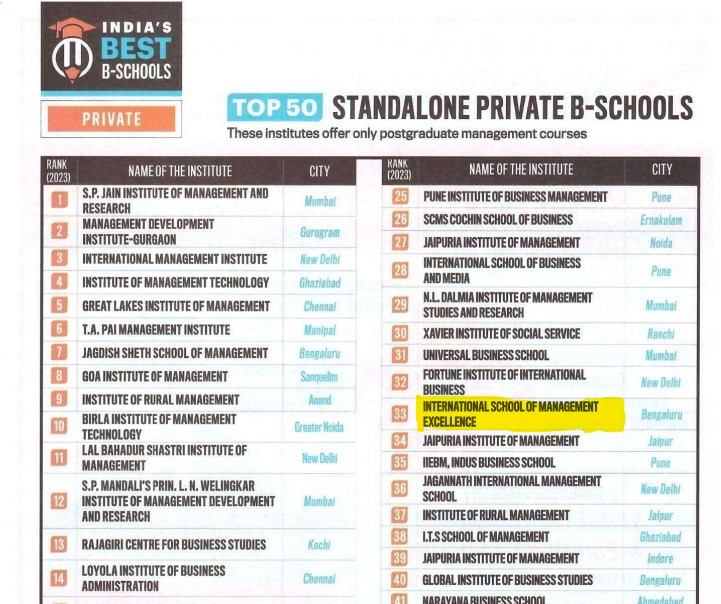23rd May 2025
Sandip, a B.Com graduate from West Bengal, is aspiring to pursue a PGDM from a reputed business school. He is actively exploring his options in search of the right institute. Given his personal aptitude and past academic performance, he realises that gaining admission to the IIMs may not be feasible. However, he is determined to build a strong career in the Finance domain and secure a position in a reputed corporate organisation. With a background in Science until his 12th grade and strong school-level mathematics, he has a solid grasp of numbers, often better than many of his classmates. Sandip is also confident in his communication skills and general awareness, although he acknowledges that public speaking is an area where he needs improvement.
He began his search on Google, looking for good B-schools in South India, as his parents are more comfortable with him studying in the South rather than in Northern India. His online research led him to several reputed business schools in Bangalore, and gradually, he became inclined toward pursuing his postgraduate studies there.
On the other side, a reputed B-school in Bangalore, Innov, strategically focuses on attracting the next tier of high-potential students, recognizing that top IIM aspirants may not consider it as their first choice. Nonetheless, Innov is committed to maintaining student quality and actively seeks capable candidates. To achieve this, the school leverages digital marketing and search engine optimization techniques to reach prospective students actively searching online. This article explores how full-funnel marketing adopted by Innov played a key role in guiding Sandip—a driven and capable student—to discover and ultimately choose Innov, a B-school that prioritizes quality without compromise.
Full-funnel marketing is a strategic approach that delivers compelling messages at every stage of the customer journey using the most effective marketing channels. Its primary objective is to create a seamless and engaging experience as the customer moves through the stages of Awareness → Consideration → Conversion. It aims to guide potential customers from the moment they recognize a need, through evaluating available options, to ultimately making a purchase—and ideally, becoming repeat customers.
This approach optimally leverages various marketing channels—such as digital ads, websites, blogs, and social media—to ensure that every touchpoint leaves a positive impression of the brand. Full-funnel marketing takes a holistic approach, not just focusing on sales, but also on building long-term brand loyalty. Importantly, the customer journey is rarely linear; it is often fragmented. A prospective customer might first see a TV ad, then visit the website, read blog content, and browse online reviews before making a decision. Full-funnel marketing is designed to keep the brand relevant and engaging throughout this entire, non-linear journey.
How Innov B-School uses Full-Funnel Marketing to attract quality students?
In this case study, the B-school Innov in Bangalore effectively leverages full-funnel marketing to reach its target audience and meet their expectations at each stage of the customer journey.
1. Top of the funnel: building awareness through targeted outreach-
To create brand awareness and attract the right audience, Innov begins by crafting detailed buyer personas. Alumni play a critical role in this stage—they share relevant content and insights to answer common questions that prospective PGDM students may have. These alumni stories help resonate with student aspirations, concerns, and goals, making them relatable representatives of the brand.
The B-school also uses traditional and digital media to widen its reach. This includes:
- Print ads in national newspapers
- Radio advertisements and physical banners
- A well-optimized website for organic search
- Engaging blog posts and academic content on platforms like Facebook, Instagram, Twitter, and LinkedIn
- Listings on educational portals like Shiksha, CollegeDunia, and GetMyUni and in the professional social media LinkedIn.
Together, these efforts build strong brand visibility in both local and national markets.
2. Middle of the Funnel: Engaging and Differentiating the Brand
At this stage, Innov focuses on building preference and positioning itself as a top choice. Instead of aggressive promotions, it uses trust-building techniques:
- Academic content delivered by faculty members
- Participation in education fairs and trade shows
- Testimonials from current students, alumni, and recruiters
- Webinars that provide value and foster interaction
This phase helps prospects move from casual interest to serious consideration by highlighting the school’s strengths and credibility.
3. Bottom of the Funnel: Converting Prospects into Enrollments
When students begin the application process, Innov supports them with:
- Scholarships and instalment payment options
- Loan assistance and transparent communication around ROI (Return on Investment)
- A structured selection process to maintain student quality
- Personalized emails to build confidence and reinforce brand commitment.
Post-enrolment, Innov continues to nurture relationships by offering referral rewards and encouraging word-of-mouth marketing, turning students into brand advocates.
4. Data-Driven Insights and KPI Measurement
Innov relies heavily on data analytics to track performance at every stage of the funnel. By analyzing customer actions and campaign effectiveness, the school fine-tunes its messaging and channel strategies.
- Top of the Funnel KPIs: Brand awareness, website traffic, reach and impressions
- Middle of the Funnel KPIs: Qualified leads, webinar participation, content downloads
- Bottom of the Funnel KPIs: Applications submitted, enrollment numbers, revenue generated
This data-driven approach allows the school to continuously optimize its marketing strategy and maximize ROI.
Conclusion: A Win-Win with Full-Funnel Marketing
Innov’s holistic full-funnel marketing strategy ensures that prospective students enjoy a consistent and enriching experience—whether through a blog, social media post, email, or alumni recommendation. For the brand, it means attracting quality students and standing out in a highly competitive market. As seen in Sandip’s journey, this approach creates a win-win outcome where both the student and the B-school benefit—demonstrating the power of full-funnel marketing in higher education.
This caselet is appropriate to be discussed in the Term II- Marketing and Sales Promotion (MKMSP22426) course.
Questions to be discussed in the class-
- How does Full-Funnel Marketing differ from traditional marketing approaches in the context of higher education, and why is it more effective in attracting students like Sandip?
- In what ways can data analytics enhance the effectiveness of Full-Funnel Marketing in educational institutions?
- Beyond admissions, how can educational institutions leverage the full-funnel approach to build long-term brand loyalty and advocacy among students and alumni?



